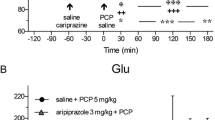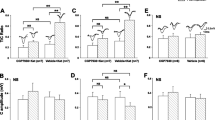Summary
It has been confirmed that 24 hours following a series of electroconvulsive shocks (ECS) given once daily for 10 days (ECS×10) to rats there is an increase in GABA concentration in the corpus striatum. A similar change was seen after the ECS had been given to rats anaesthetised with halothane, or when 5 ECS were given spread out over 10 days, the rats being anaesthetised during the ECS. A daily convulsion for 10 days elicited by flurothyl exposure resulted in an increased striatal GABA concentration, but also increased the GABA concentration in the hypothalamus, hippocampus and cortex. The increase in striatal GABA concentration was present 24 hours after ECS daily for 5 days or 3 days after ECS daily for 10 days. No change in [3H]-diazepam binding was seen in hippocampus, cortex or corpus striatum 24 hours after the last of 10 once daily ECS. The increase in striatal GABA concentration was therefore seen at all times when enhanced monoaminemediated behaviours have been demonstrated following seizures.
Similar content being viewed by others
References
Bowdler, J. M., Green, A. R.: Regional rat brain GABA concentrations following repeated seizures. Br. J. Pharmac.76, 89 P (1982 a).
Bowdler, J. M., Green, A. R.: Regional rat brain benzodiazepine number and GABA concentration following a seizure. Br. J. Pharmac.76, 291–298 (1982 b).
Costain, D. W., Green, A. R., Grahame-Smith, D. G.: Enhanced 5-hydroxytryptamine mediated behavioural responses in rats following repeated electroconvulsive shock: relevance to the mechanism of the antidepressant effect of electroconvulsive therapy. Psychopharmacology11, 167–170 (1979).
Cott, J., Engel, J.: Suppression by GABAergic drugs of the locomotor stimulation induced by morphine, amphetamine and apomorphine: evidence for both pre- and post-synaptic inhibition of catecholamine systems. J. Neural Transm.40, 253–268 (1977).
Cowen, P. J., Nutt, D. J., Green, A. R.: Enhanced 5-hydroxytryptamine and dopamine mediated behavioural responses following convulsion II: the effects of anaesthesia and current conditions on the appearance of enhanced responses following electroconvulsive shock. Neuropharmacology19, 901–906 (1980 a).
Cowen, P. J., Nutt, D. J., Green, A. R.: Repeated electroconvulsive shock does not increase the susceptibility of rats to a cage convulsant (isopropylbicyclophosphate). Neuropharmacology19, 1025–1026 (1980 b).
Deakin, J. F. W., Owen, F., Cross, A. J., Dashwood, M. J.: Studies on possible mechanisms of action of electroconvulsive therapy; effects of repeated electrically induced seizures on rat brain receptors for monoamines and other neurotransmitters. Psychopharmacology73, 345–349 (1981).
Evans, J. P. M., Grahame-Smith, D. G., Green, A. R., Tordoff, A. F. C.: Electroconvulsive shock increases the behavioural responses of rats to brain 5-hydroxytryptamine accumulation and central nervous system stimulant drugs. Br. J. Pharmac.56, 193–199 1976).
Fink, M., Kahn, R. L., Karp, E., Pollack, M., Green, M. A., Allan, B., Lefkowits, H. J.: Inhalant-induced convulsions. Significance for the theory of the convulsive therapy process. Arch. gen. Psychiat.4, 259–266 (1961).
Glowinski, J., Iversen, L. L.: Regional studies of catecholamines in the rat brain-I. The disposition of [3H]-norepinephrine, [3H]-dopamine and [3H]-dopa in various regions of the brain. J. Neurochem.13, 655–669 (1966).
Grahame-Smith, D. G., Green, A. R., Costain, D. W.: The mechanism of the antidepressant action of ECT.Lancet I, 254–257 (1978).
Green, A. R.: Repeated exposure of rats to the convulsant agent flurothyl enhances 5-hydroxytryptamine and dopamine mediated behavioural responses. Br. J. Pharmac.62, 325–333 (1978).
Green, A. R.: The behavioural and biochemical consequences of repeated electroconvulsive shock administration to rats and the possible clinical relevance of these changes. In: Enzymes and Neurotransmitters in Mental Disease (Usdin, E., Sourkes, T. L., Youdim, M. B. H., eds.), pp. 455–467. Chichester: J. Wiley. 1980.
Green, A. R., Heal, D. J., Grahame-Smith, D. G.: Further observations on the effect of repeated electroconvulsive shock on the behavioural responses of rats produced by increases in the functional activity of brain 5-hydroxytryptamine and dopamine. Psychopharmacology52, 195–200 (1977).
Green, A. R., Peralta, E., Hong, J-S., Mao, C. C., Atterwill, C. K., Costa, E.: Alterations in GABA metabolism and met-enkephalin content in rat brain following repeated electroconvulsive shock. J. Neurochem.31, 607–611 (1978).
Green, A. R., Sant, K., Bowdler, J. M., Cowen, P.J.: Further evidence for a relationship between changes in GABA concentration in rat brain and enhanced monoamine-mediated behaviours following repeated electroconvulsive shock. Neuropharmacology (in press, 1982).
Green, A. R., Tordoff, A. F. C., Bloomfield, M. R.: Elevation of brain GABA concentrations with amino-oxyacetic acid; effect on the hyperactivity syndrome produced by increased 5-hydroxytryptamine synthesis in rats. J. Neural Transm.39, 103–112 (1976).
Guidotti, A., Cheney, D. L., Trabucci, M., Doteuchi, M., Wang, C., Hawkins, R. A.: Focussed microwave irradiation: a technique to minimise postmortem changes in cyclic nucleotides, Dopa and choline and to preserve brain morphology. Neuropharmacology13, 1114–1121 (1974).
Karliner, W., Padula, L.: Indoklon combined with pentothal and Anectine. Am. J. Psychiat.115, 1041–1042 (1959 a).
Karliner, W., Padula, L.: Improved technique for Indoklon convulsive therapy. Am. J. Psychiat.116, 358 (1959 b).
Krantz, J. C., Equibel, A., Truitt, E. B., Ling, A. S. C., Kurland, A. A.: Hexaflurodiethylether (Indoklon)-an inhalant convulsant-its use in psychiatric treatment. J. Am. med. Assoc.166, 1555–1562 (1958).
Lebrecht, U., Nowak, J. Z.: Effect of single and repeated electroconvulsive shock on serotonergic system in rat brain. II Behavioural Studies. Neuropharmacology19, 1055–1061 (1980).
Lowry, O. H., Rosebrough, N. H., Farr, A. L., Randall, R. L.: Protein measurement with the Folin phenol reagent. J. Biol. Chem.193, 265–276 (1951).
McNamara, J. O., Peper, A. M., Patrone, V.: Repeated seizures induce longterm increase in hippocampal benzodiazepine receptors. Proc. Natl. Acad. Sci. U.S.A.77, 3029–3032 (1980).
Modigh, K.: Electroconvulsive shock and postsynaptic catecholamine effects: increased psychomotor stimulant action of apomorphine and clonidine in reserpine pretreated mice by repeated ECS. J. Neural Transm.36, 19–32 (1975).
Nutt, D. J., Cowen, P. J., Green, A. R.: On the measurement in rats of the convulsant effect of drugs and the changes which follow electroconvulsive shock. Neuropharmacology19, 1017–1923 (1980).
Spreche, D. A.: A quantitative comparison of electroconvulsive therapy with hexaflurodiethylether. J. Neuropsychiat.5, 132–137 (1964).
Wielosz, M.: Increased sensitivity to dopaminergic agonists after repeated electroconvulsive shock (ECS) in rats. Neuropharmacology20, 941–945 (1981).
Author information
Authors and Affiliations
Rights and permissions
About this article
Cite this article
Bowdler, J.M., Green, A.R., Minchin, M.C.W. et al. Regional GABA concentration and [3H]-diazepam binding in rat brain following repeated electroconvulsive shock. J. Neural Transmission 56, 3–12 (1983). https://doi.org/10.1007/BF01243369
Received:
Issue Date:
DOI: https://doi.org/10.1007/BF01243369




